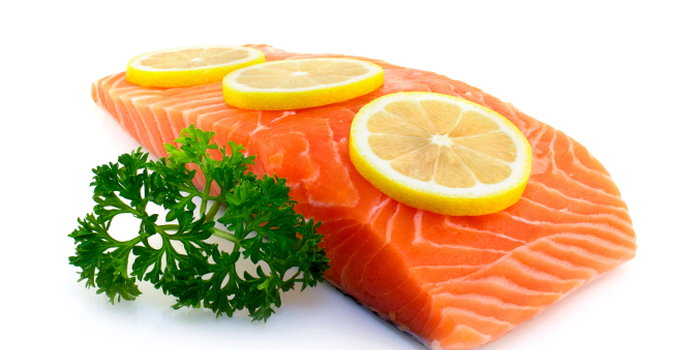Omega 3's are a group of unsaturated fatty acids, and include alpha-linolenic acid (ALA), eicosapentaenoic acid (EPA), and docosahexaenoic acid (DHA). DHA fatty acid is the primary oil in fish, which has been shown to have some health benefits, including the reducing of heart disease by lowering blood triglyceride levels. DHA is also the primary fatty acid in the human brain, and the deficiency has been linked to cognitive decline and possibly Alzheimer's disease.
ALA is the shortest chain fatty acid, and predominant in plant-based sources of omega-3's. EPA and DHA have the most research for health benefits, and are mostly available in seafood. The body can convert some of the ALA consumed from foods into EPA and DHA in the body, but in a much smaller amount than eating foods rich in DHA.
Sources of DHA Omega 3 fatty acids include:
1. Salmon
Salmon has the highest content of DHA of any fish source, ranging from 2000 to 3000 milligrams per 6 ounce serving. Wild salmon has more usable fish oil than farm-raised salmon. The best variety of salmon to choose is the Atlantic salmon, but Coho, pink and sockeye salmon are also good choices.
2. Bluefin or Albacore Tuna
Fresh bluefin tuna has the highest amount of DHA of any of the tuna varieties. Canned tuna can be a good source, and may be more economical. Look for a white albacore tuna canned in water, which contains 3 times as much DHA as "light" tuna canned in water, and 6 times as much as light tuna canned in oil, according to the USDA Database analysis.
3. Swordfish
This fish is also high in DHA, 1390 mg per 6 ounce serving. It is best to cook the fish using a dry heat method, such as baking or grilling. Swordfish is not recommended for consumption by pregnant women or children, as they may have higher levels of mercury from ocean contaminants.
4. Anchovies, Herring and Sardines
These small fish can contain up to 840 milligrams of omega 3 fatty acids per 3-ounce can. European anchovy canned in oil is a better source than raw. For herring, the Atlantic variety has more DHA than the Pacific fish. Of the three, sardines have the lowest amount of DHA.
5. Caviar or Fish Roe
6. Algae
For vegetarians who do not eat fish, other sources of omega 3 fatty acids can be eaten such as walnuts, flaxseeds and tofu. However, these do not contain DHA, which is almost solely found in sea life. Algae is a source of DHA omega 3's that even vegans find suitable, and can be purchased as a supplement product.
7. Breastmilk and Infant Formula
For small children, the most important source of DHA is mother's milk. If that is not possible, infant formula manufacturers have recognized the importance of DHA on children's developing brains and have begun to add this ingredient to many of their products.
Be sure to use the online food journal at Fitday to track your Omega-3 intake.



